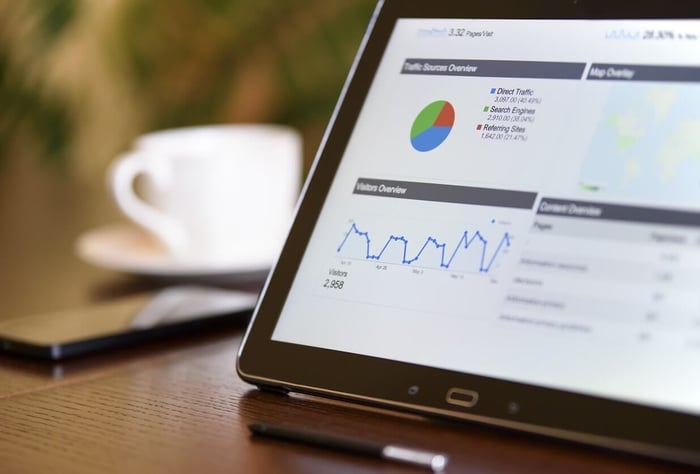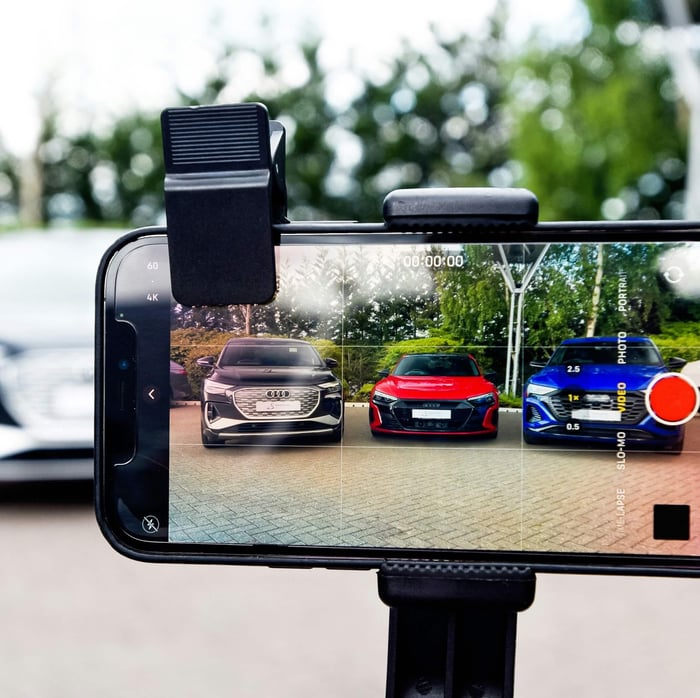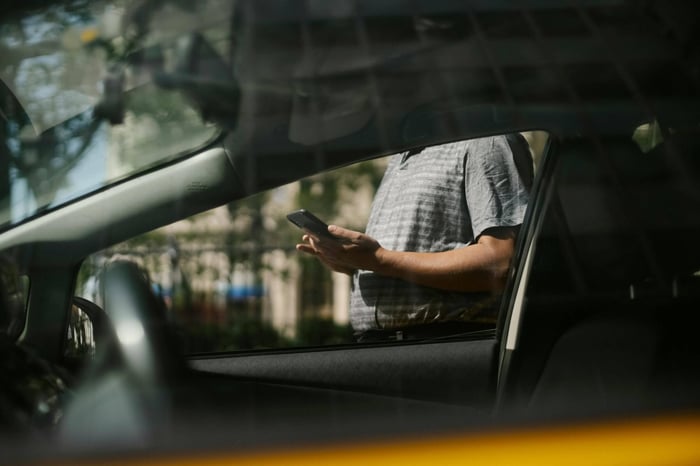Are you looking to boost sales at your auto dealership? From leveraging social media sites to compelling content creation, you’ll discover actionable tactics to attract more customers and drive your sales performance.
Key Takeaways
Combining traditional and digital automotive marketing strategies is essential for dealerships to reach a wider audience and enhance brand visibility.
Creating engaging social media content and employing influencer marketing tactics can greatly improve customer interactions, build trust with your dealership, enhance its visibility, and foster stronger connections with potential car buyers.
Data-driven marketing and personalized communications, such as targeted ads and customer reviews, are crucial for nurturing leads and enhancing consumer loyalty.
Understanding Auto Dealership Marketing

Effectively navigating the competitive landscape of the automotive industry requires a well-crafted automotive marketing strategy. The primary goal of automotive marketing is to connect auto dealerships with potential car buyers, ultimately leading to car sales. To do this effectively involves a combination of traditional and digital marketing tactics tailored to attract customers, build the brand, and create a loyal customer base.
Car dealerships must adapt their marketing strategies to stay relevant in a competitive marketplace. As customer preferences evolve, tailoring your automotive marketing campaigns to align with these changes ensures more effective engagement and stronger connections with your audience.
The Role of Automotive Marketing
Automotive marketing is crucial in converting prospects into paying customers in the automotive business. By leveraging engaging digital content, auto dealerships can boost brand recognition and position themselves as trusted authorities in the industry. This approach enhances brand recognition, attracts customers, and drives car sales through well-crafted automotive marketing strategies and campaigns.
By using targeted online advertising, car dealerships can effectively reach specific demographics. This approach helps connect with potential customers, stand out in a crowded market, and boost car sales by focusing on the target audience.
Knowing Your Audience
Knowing your audience is important for any successful automotive marketing strategy. To better connect with potential buyers, learn about their preferences, pain points, and the steps of their decision-making processes. Tailoring your messaging to address their unique circumstances can significantly increase engagement and conversions.
You can engage in audience research to learn more about your audience. Begin by analyzing key demographic factors such as age, gender, income level, and location. You can also consider other insights like buyer motivations, lifestyle choices, and brand preferences. By building detailed buyer personas, you can refine your messaging and offer relevant content directly to them.
Here are some strategies you can use to effectively target and engage customers:
Segment your audience: Divide potential customers into distinct groups, such as vehicle preference, purchasing power, or location, to create more relevant and targeted messaging.
Leverage data analytics: Use tools like Google Analytics, social media insights, or CRM data to track target audience behavior, identify trends, and measure engagement.
Utilize customer feedback: Gather insights from reviews, surveys, and social media comments to better understand customer expectations, experiences, and preferences.
A/B test campaigns: Regularly test different messages, designs, and offers to identify what resonates most with each audience segment.
Monitor competitor behavior: Analyze your competitors’ marketing strategies to identify opportunities and gaps in reaching shared audiences.
Traditional vs. Digital Marketing Strategies
Combining traditional and digital marketing is essential to reach a broader audience in the automotive market. Traditional methods like direct mail, newspapers, and radio often yield significant ROI, especially with targeted campaigns.
Comparatively, digital marketing strategies offer the advantage of reaching a wider target audience. Utilizing social media platforms, search engine optimization, and Google Ads can significantly boost online visibility and engagement. Blending these methods creates a comprehensive marketing plan that maximizes reach and effectiveness.
For both traditional and digital marketing, it's important to focus on mastering a few key channels before expanding to others. By concentrating on marketing channels where your target audience is most active, you can optimize your efforts and better allocate your resources. Once you understand the methods that deliver the best results, you can diversify your customer acquisition channels. This can help you ensure consistency and maximize ROI.
Leveraging Social Media Platforms
Social media is essential in modern automotive marketing tactics, with approximately 22% of new vehicle buyers interacting with brands on these platforms. A strong presence boosts visibility and enables direct customer engagement.
Active engagement on social media also helps build consumer loyalty and fosters long-term relationships. Younger generations, especially Gen Z, often rely on social media as their primary source of product information, making it crucial for dealerships to leverage their presence on these platforms.
"The watch time of 'test drive' videos on YouTube has grown by more than 65% in the past 2 years."
Creating Engaging Content
High-quality, engaging content is crucial for attracting and retaining customers on social media. Dealerships can post inventory photos and videos, customer testimonials, and reviews. Sharing insights on common questions, car buying tips, and the latest automotive trends keeps the target audience informed and engaged.
Using storytelling in social media content builds emotional connections, making the car dealership more relatable. Personalized video content strengthens the rapport between salespeople and customers, enhancing trust and loyalty.
Utilizing Influencer Marketing

Influencer marketing is a powerful tool for promoting products and services while building your credibility. By collaborating with reputable influencers, dealerships can amplify brand awareness and reach diverse audiences. Influencers can create various types of content, including videos of test drives, reviews, and behind-the-scenes looks, to engage their followers.
Partnering with trusted influencers helps dealerships leverage existing consumer trust. This boosts brand visibility and strengthens brand image, ultimately attracting potential customers and increasing car sales.
Enhancing Your Online Presence
A strong online presence is crucial for car dealerships to effectively engage potential buyers and drive sales. With most consumers researching cars online, a mobile-optimized website provides a smooth browsing experience, crucial for capturing and retaining interest.
A user-friendly and fast-loading website enhances customer experience and increases conversion rates. Using SEO best practices and Google Ads also improves online visibility and attracts more organic traffic.
"95% of car shoppers rely on online resources to gather information, bypassing dealerships as their starting point."
Search Engine Optimization (SEO)
SEO is critical for improving a dealership’s visibility in search results and increasing organic traffic. With 70% of consumers researching cars through search engines, efficient SEO is vital for dealerships' success.
Optimizing your website’s structure and content for relevant keywords can improve search visibility and attract more potential customers. Additionally, managing online reputation is crucial, as negative reviews on the first page of search results can result in losing up to 22% of potential customers.
Google Ads
Google Ads boost car dealership visibility by driving targeted traffic to their websites through well-planned pay-per-click (PPC) campaigns. Effective campaigns rely on thorough keyword research to reach specific demographics and attract relevant customers.
Combining Google Ads with SEO creates a strong online presence, increases qualified traffic, and drives more car sales. This dual approach significantly improves online visibility and overall marketing effectiveness.
Importance of Photos and Videos
High-quality photos and videos are essential for automotive marketing, influencing consumer perceptions and purchasing decisions. Visual content showcases vehicles effectively and enhances the customer experience. Consistent visuals build consumer trust and reflect professionalism.
High-resolution images and engaging videos are key to attracting potential customers. Clear, accurate, and appealing content captures buyers’ attention and encourages exploration of your offerings.
Video Marketing

Video marketing is gaining popularity in the automotive industry for its ability to enhance brand visibility and engage audiences. Dealerships can showcase vehicles and customer testimonials through engaging videos, while influencer marketing can extend brand reach with content like vehicle reviews and test drives.
"40% of car shoppers discover new vehicles they weren't previously considering because of video marketing."
Augmented and virtual reality further enhance the shopping experience by offering realistic vehicle simulations. With 63% of consumers preferring test drives without a salesperson, video marketing becomes a valuable tool for dealerships to provide immersive, informative experiences.
Visual Content Best Practices
To gain buyer attention, visual content should feature clear, high-resolution images with accurate colors. Engaging storytelling and emotional appeal are crucial for impactful visual content. Prioritizing these elements helps dealerships create compelling visual content that resonates with potential buyers and enhances their automotive marketing strategy.
Incorporating these elements into your visual content enhances user engagement and builds a strong brand image. This attracts customers and helps retain them by providing a professional and trustworthy representation of your offerings.
Email Marketing Campaigns
Email marketing is a powerful tool for engaging potential customers, nurturing leads, and promoting offers. Effective campaigns build brand awareness and encourage repeat interactions. Marketing automation supports this by managing workflows and ensuring consistent follow-ups, which guide leads through the purchasing process.
"Nearly a quarter (23.5%) of dealer leads miss 24-hour follow-up, and 13.3% vanish before CRM entry."
Personalization and Segmentation
Personalized emails significantly enhance engagement by tailoring content to specific interests, resulting in a 28% higher click-through rate. Segmenting email lists allows for targeted messaging, increasing relevance and improving response rates among different customer groups.
Automated Email Sequences
Automated email sequences keep regular communications with your contacts, reinforcing brand loyalty and boosting repeat car sales. They are crucial for maintaining engagement through timely, personalized interactions.
These sequences foster trust and familiarity, enhancing customer retention and encouraging long-term loyalty. By staying top-of-mind with potential buyers, dealerships can effectively nurture leads and increase repeat business.
"Dealers using marketing automation are twice as likely to see a higher return on investment (ROI) for their marketing efforts compared to those who don't."
Data-Driven Marketing Strategies
Regular data monitoring is crucial for staying competitive and making informed marketing decisions. Analytics reveal insights into customer behavior, market trends, and campaign performance, allowing for strategic adjustments. For instance, tracking website traffic and user engagement helps refine marketing strategies to better target potential customers.
Customer Behavior Insights
Analyzing online customer interactions provides valuable insights into the customer journey, enhancing sales. Understanding these behaviors allows dealerships to tailor marketing efforts, improving the shopping experience and increasing engagement.
Triggered emails, for example, have an average of over 70% more opens than standard bulk messages. Hosting interactive events, like test drives, can also convert prospects into paying customers by aligning marketing efforts with buyers' needs and preferences.
Measuring Success
Assessing key performance indicators (KPIs) helps evaluate the efficiency of marketing efforts. Key metrics to monitor include:
Website traffic
Conversion rates
Engagement levels
Customer satisfaction
Reviewing these metrics, along with using call tracking technology, provides valuable insights into campaign effectiveness. Regular analysis allows dealerships to refine strategies, enhance performance, and achieve better results.
Hosting Community Events
Community events are a powerful way for dealerships to connect with local audiences and build a strong brand image. By hosting test drives and engaging directly with attendees, dealerships can showcase their offerings and increase the likelihood of converting visitors into customers.
Exclusive events for loyal customers further strengthen brand connections and foster a sense of community. Such involvement enhances trust, boosts visibility, and drives foot traffic to the dealership.
Test Drive Events

Test drive events let potential customers experience vehicles firsthand, leading to higher conversion rates. These events showcase multiple car models, building customer connections with both the vehicle and the car dealership.
Offering test drives enhance trust by allowing buyers make informed decisions based on personal experience, significantly impacting sales and overall customer satisfaction.
Sponsoring Local Activities

Sponsoring local activities enhances the visibility of your auto dealership and builds a favorable reputation within the community. This can include sponsoring local sports teams, charity events, or community festivals.
This type of community engagement boosts foot traffic and fosters customer loyalty, creating a positive brand image and solidifying the dealership’s local presence.
Customer Loyalty Programs
Customer loyalty programs enhance customer retention and satisfaction by encouraging repeat purchases. Memberships offer exclusive benefits, like priority maintenance and access to private events, creating a sense of belonging.
VIP services enhance the customer experience and significantly improve retention by rewarding loyal customers.
Exclusive Discounts and Offers
During car-buying holidays, expect discounts around 7.5% to 8% below MSRP. Loyalty program points can be used for discounts or free services, rewarding and retaining loyal customers.
These discounts and offers attract new customers and encourage existing customers to continue doing business with the dealership. This approach helps local dealerships stay competitive and drive increased sales.
VIP Services
Loyal customers often enjoy benefits such as access to exclusive events and VIP treatment, including priority maintenance services that ensure their needs are addressed promptly. These perks are designed to reward and enhance the overall customer experience.
Offering VIP services also fosters long-term loyalty by making customers feel valued and appreciated, encouraging them to continue their relationship with the car dealership.
Adapting to Online and Out of State Car Buying Trends
The COVID-19 pandemic pushed more people to explore online car buying, making convenience a top priority. This shift has changed how automotive dealerships and customers interact, so staying competitive means adapting to these new trends in the automotive industry.
Dealerships must offer a seamless online shopping experience to attract and retain customers. This includes providing virtual showrooms and nationwide delivery options to cater to out-of-state buyers.
Virtual Showrooms
3D virtual showrooms can simulate real environments of the dealership. They enable customers to explore a dealership’s vehicle inventory through immersive 360-degree views. This provides customers with a seamless online shopping experience by allowing them to explore vehicle offerings from the comfort of their own homes.
Virtual showrooms can significantly enhance the customer experience and attract potential buyers who prefer shopping online.
Nationwide Delivery Options
Offering nationwide delivery helps dealerships reach a broader audience by eliminating geographical limitations. Effective logistical planning is crucial for implementing this option successfully. Streamlined delivery processes simplify the buying experience, enhance convenience, and drive sales, expanding your market reach.
Optimizing Mobile Marketing

Mobile marketing is vital for dealerships to connect with potential buyers, as nearly half of all web traffic comes from mobile devices. Car dealerships must prioritize mobile-friendly website designs and ensure images are optimized for smaller screens.
Optimizing websites for mobile, creating mobile-friendly ads, and leveraging SMS marketing are key strategies. These practices enhance the browsing experience for users, boosting engagement and increasing conversion rates.
Mobile-Friendly Websites
Having a user-friendly website that is optimized for mobile devices is crucial, as a large percentage of users access websites from mobile devices. Dealerships should focus on creating mobile-friendly websites, ads, and SMS marketing campaigns as part of their mobile strategy.
Optimizing for mobile enhances user engagement and drives more traffic to your site, catering to potential buyers who prefer using smartphones for their car shopping experiences.
SMS Marketing

SMS marketing allows dealerships to send timely updates on new arrivals, promotions, and service reminders directly to customers. With an impressive open rate of 98%, SMS far surpasses email's typical 20% open rate.
By leveraging SMS marketing, dealerships can stay connected with customers, enhance engagement, and boost sales through effective, timely communication.
Utilizing Direct Mail Campaigns

Direct mail is an effective strategy for reaching audiences less engaged with digital channels and targeting new customer segments. When integrated with online advertising, it expands your reach and boosts customer engagement.
Combining direct mail with digital marketing provides a comprehensive approach, enhancing overall sales and driving more traffic to the showroom.
Personalized Mailers
Personalized mailers can significantly enhance engagement by addressing specific audience segments with tailored messages. Customized mailers achieve response rates of up to 6%, significantly higher than the standard 2% for generic mail.
The combination of individual address and targeted content in personalized mailers drives higher engagement and response rates. This can help car dealerships connect with their target audience more effectively and boost sales.
Tracking and Measuring Response
Using unique tracking methods, like specific phone numbers or URLs, allows for accurate measurement of response to direct mail campaigns. Tracking tools, like QR codes, in mailers allows businesses to analyze recipient behavior and refine future campaigns based on insights gathered.
Building Trust through Customer Reviews
Customer reviews are crucial in automotive marketing by building trust and influencing purchasing decisions. Positive reviews enhance credibility and can significantly impact sales. For example, a one-star increase in a Yelp rating can lead to a 5-9% boost in revenue. Conversely, negative reviews can undermine trust and hinder customer acquisition.
Favorable feedback improves a dealership’s credibility and legitimacy, encouraging purchases. Gathering customer feedback through Customer Satisfaction Index (CSI) surveys can help you understand the customer experience. A high CSI score indicates an understanding of customers’ needs and signals likely satisfaction.
Encouraging Positive Reviews
Approximately 65% of customers are willing to provide a review if simply asked. Two effective methods to collect customer reviews are to ask for them upon sale finalization and to follow up with an incentive email.


